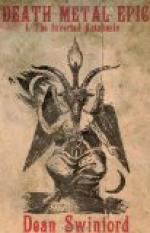Sure that the monster can no longer molest them, the rest of the warriors press forward in their turn, and receive the farewells of their dying chief, who, after rehearsing the great deeds he has done, declares he is about to close honorably an eventful career. When he has breathed his last, his followers push the corpse of the dragon off a cliff into the sea, and erect on the headland a funeral barrow for Beowulf’s ashes, placing within it part of the treasure he won, and erecting above it a memorial, or bauta stone, on which they carve the name and deeds of the great hero who saved them from Grendel and from the fiery dragon.
So lamented mourning the men of the Geats,
Fond-loving vassals the fall of their
lord,
Said he was kindest of kings under heaven,
Gentlest of men, most winning of manner,
Friendliest to folk-troops and fondest
of honor.
FOOTNOTES:
[Footnote 21: See also the author’s “Legends of the Middle Ages.”]
[Footnote 22: All the quotations in this chapter are taken from Hall’s translation of “Beowulf.”]
THE ARTHURIAN CYCLE
The Arthurian cycle consists in a number of epics or romances about King Arthur, the knights of his Round Table, or the ladies of his court. The Anglo-Norman trouveres arranged these tales in graduated circles around their nucleus, the legend of the Holy Grail. Next in importance to this sacred theme, and forming the first circle, were the stories of Galahad and Percival who achieved the Holy Grail, of Launcelot and Elaine who were favored with partial glimpses of it, and of Bors who accompanied Galahad and Percival in their journey to Sarras. The second circle included the stories of Arthur and Guinevere, of Geraint and Enid, of Tristan and Isolde, of Pelleas and Ettarre, of Gareth and Lynette, of Gawain, and of Bedevere. The third and last circle dealt with the epics of Merlin and Vivien, Uther and Igerne, Gorlois, and Vortigern.
To give a complete outline of the adventures which befell all these knights and ladies in the course of seventeen epics and romances,—of which many versions exist, and to which each new poet added some episode,—would require far more space than any one volume would afford. A general outline will therefore be given of the two principal themes, the Quest of the Holy Grail and King Arthur and his Round Table, mentioning only the main features of the other epics as they impinge upon these two great centres.
Some of the greatest writers of the Arthurian cycle have been Gildas, Nennius, Geoffrey of Monmouth, Wace, Robert de Borron, Marie de France, Layamon, Chrestien de Troyes, Benoit de St. Maur, Gaucher, Manessier, Gerbert, Knot de Provence, Wolfram von Eschenbach, Gottfried von Strassburg, Hartmann von der Aue, Malory, Tennyson, Swinburne, Howard Pyle, Matthew Arnold, and Wagner. Still, almost every writer of note has had something to say on the subject, and thus the Arthuriana has become almost as voluminous as the Shakespeariana. The legend of Arthur, almost unknown before the twelfth century, so rapidly became popular all over Europe, that it was translated into every language and recited with endless variations at countless firesides.




